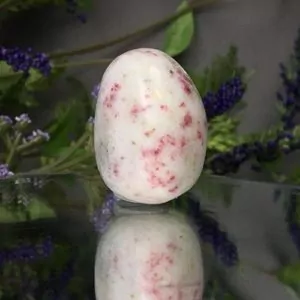Keywords: Transformation ~ Manifestation
Hardness: 2 - 2.5
Zodiac: Leo, Sagittarius
Chakra: Root
Planet: Mercury
Element: Fire
Locations Found: China, Mexico, Spain
Tarot Card: The Magician

Keywords: Transformation ~ Manifestation
Hardness: 2 - 2.5
Zodiac: Leo, Sagittarius
Chakra: Root
Planet: Mercury
Element: Fire
Locations Found: China, Mexico, Spain
Tarot Card: The Magician
Due to Cinnabar’s mercury content it is associated with the God Mercury and the process of alchemical transformation. Working with this stone can support you in burning away that which hides your truest self from shining. Cinnabar is grounding, assisting you in bringing your highest potential into this reality. It is said to have a strong energy that can help stimulate the energy in the body and help to improve physical vitality and health.
In addition to its grounding and transformative properties, cinnabar is also believed to have a positive effect on one’s creativity and self-expression. It is said to help stimulate the imagination and help one to bring their creative visions to life.
Cinnabar was used during the Upper Paleolithic period as pigment for ceramics, murals, tattoos and religious ceremonies. To create the vibrant orange pigment, cinnabar would be ground into a fine powder and mixed with various liquids to create vermillion.
It was used in China around 4000 BC to cover the walls and floors in buildings where rituals were held and was also sometimes sprinkled into elite burials. It was used in traditional medicine and was believed to have healing properties. It was also used in the production of ink for calligraphy and was believed to have mystical powers.
Cinnabar was also used as a cosmetic in India, women used the vermillion pigment as the traditional Bindi and along the parting of their hair when they were married. This powerful stone was also used in medicines such as ointments, laxatives, antiseptics and many traditional medicines but has largely been replaced by much safer remedies.
Cinnabar is a mercury sulfide (HgS), which gives it its distinctive red color. It should be handled with care, wash hands after handling. It is formed around volcanoes, hot springs and sometimes in sedimentary rocks associated with recent volcanic activity.
Because of its mercury content, cinnabar can be toxic if ingested or inhaled, so care must be taken when handling the mineral. It is best to use cinnabar in its polished or tumbled form and handle it with care.
Cinnabar works well with other grounding and stabilizing stones such as Black Tourmaline and Hematite. It can also be used in combination with stones that enhance creativity and intuition, such as Amethyst and Citrine.
